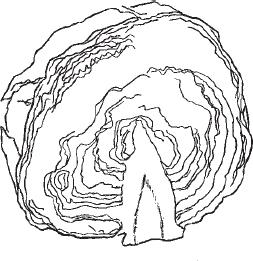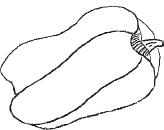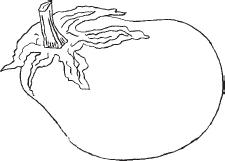Nourishing Traditions: The Cookbook That Challenges Politically Correct Nutrition and The... (100 page)
Authors: Sally Fallon,Pat Connolly,Phd. Mary G. Enig
Tags: #Non-Fiction, #Reference, #Science, #Health
Know Your Ingredients
Name This Product # 17
Enriched macaroni, dried cheddar cheese, corn starch, partially hydrogenated soybean oil, dried tomato, salt, buttermilk, sugar, hydrolyzed vegetable protein and other natural flavorings, dried onion, dried corn syrup, disodium phosphate, dried garlic, sodium caseinate, citric acid, dipotassium phosphate, FD&C yellow No. 5 and other artificial color, sodium sulfite and BHA.
See
Appendix B
for Answer
STUFFED CABBAGE, ORIENTAL STYLE
Serves 6
1 large cabbage
2 pounds ground turkey
2 tablespoons extra virgin olive oil
1 cup
basic brown rice2 bunches green onions, finely chopped
2 tablespoons toasted sesame oil
1 tablespoon freshly grated ginger
2 tablespoons naturally fermented soy sauce
¼ teaspoon red chile flakes
1 bunch cilantro, minced
sea salt and pepper
4 cups chicken or turkey stock (
chicken stock
)2 tablespoons arrowroot mixed with 2 tablespoons filtered water
Remove the core from cabbage and set, core side down, in a large pot containing about 2 inches of water. Cover and steam about 15 minutes. Remove wilted outer leaves and steam a bit longer, if necessary, to soften inner leaves. Strew leaves on a tea towel to drain and set aside.
In a heavy skillet, brown turkey in olive oil until crumbly. Stir in green onions, rice, green onions, sesame sauce, ginger, soy sauce, red chile flakes and cilantro. Season to taste. Place a spoonful of stuffing in each cabbage leaf, fold in sides and roll up. Arrange in several layers in a flameproof casserole and cover with stock. Bring to a boil and transfer to the oven. Bake at 300 degrees about 1 hour.
Use tongs to remove cabbage rolls to a platter and keep warm in the oven. Return the casserole and its liquid to the stove. Bring to a boil and cook vigorously about 15 minutes, stirring occasionally, until stock has reduced. Add arrowroot mixture, spoonful by spoonful, until desired thickness is obtained.
To serve, ladle sauce onto individual plates and place two or three cabbage rolls on top.
Babies fed a strict vegetarian diet. . .do not grow at a normal rate. They get shortchanged on B
12
, folic acid, zinc, calories, proteins, calcium and riboflavin (B
2
). Even a
breast-fed
baby may become malnourished if the mother has been a true vegetarian for a number of years. William Campbell Douglass, MD
The Milk Book
The propaganda blitz has been so awesome that even the
New England Journal of Medicine
. . .has abandoned science and swallowed the killer-cholesterol line. "The optimal intake of cholesterol," they editorialize, "is probably zero, meaning the avoidance of animal products."
After making this wrong-headed and unscientific statement, they temporize by admitting that "sound data are needed," "The lack of more direct human evidence remains frustrating," "In the absence of fully satisfactory data. . .a reasonable policy would seem to admit uncertainty. . ." and "we must hedge our bets." There is a certain wistfulness to this editorial as if they were saying, "Would someone please prove that our dietary recommendations have some scientific justification?" William Campbell Douglass, MD
Eat Your Cholesterol

STUFFED PEPPERS
Serves 6
6 green peppers
1 pound ground beef or other red meat
¼ pound ground heart (optional)
2 tablespoons olive oil
1 medium onion, peeled and finely chopped
1 small can tomato paste
1 cup
beef stock½ teaspoon each thyme, rosemary and oregano, fresh or dried
2 cups
basic brown rice¼ cup
crispy pine nutssea salt and pepper
1 cup grated Parmesan or Cheddar cheese
Carefully remove stems from peppers, slice in half lengthwise and remove seeds. In a heavy skillet, brown meat in olive oil until crumbly. Add onion, tomato paste, stock and herbs. Bring to a boil and cook until liquid has reduced by about one half. Stir in rice and pine nuts and season to taste. Set the pepper halves in a buttered pyrex dish, fill each with stuffing and top with cheese. Bake for about 1 hour at 350 degrees.
Rat colonies maintained during their whole lives on conventional human-style diets, or even on diets supplemented artificially with minerals and vitamins, develop many pathological conditions not seen in rats during the abbreviated course of vitamin assaying. It is difficult to avoid the inference that the appearance of disease in long-term, vitamin-supplemented diet experiments presages the need of the organism for all food constituents, including food enzymes, if optimal health and longevity are to be attained. Edward Howell, MD
Food Enzymes for Health and Longevity

GREEK BUFFET
Apricot Squares
MOUSSAKA
(Eggplant Casserole)
Serves 12-18
8-10 large eggplants
about 1 cup extra virgin olive oil
4 pounds ground lamb
3 medium onions, minced
8 ripe tomatoes, peeled, seeded and coarsely chopped or 2 cans tomatoes, drained and coarsely chopped
1 cup
beef stock
or
lamb stock1 teaspoon cinnamon
sea salt and pepper
2 cups grated Cheddar or Parmesan cheese
Moussaka makes a wonderful buffet dish, and it is a welcome and healthier alternative to lasagna. You will need a rectangular pan that is at least 2 inches deep—a stainless steel baking pan will do nicely. Do not make the mistake of skimping on the eggplant—that is what gives this dish its distinctive character.
Cut ends off eggplants and peel. Cut into
3
/
8
-inch lengthwise slices. Salt and set aside, covered with a towel, for about 1 hour. Rinse slices well, dry off, and place on cookie sheets brushed with olive oil. Generously brush top sides with olive oil and grill under broiler until lightly browned. Meanwhile, cook the lamb in a large pan until crumbly. To peel tomatoes, see
Kitchen Tips and Hints
. Add onions, tomatoes, stock, and cinnamon. Season to taste. Bring to boil, skim and simmer, uncovered, until most of the liquid has evaporated.Oil the baking pan. Arrange a layer of eggplant on the bottom, then a thin layer of the meat. Repeat for at least two more layers to give at least three layers of eggplant—but four is better. Sprinkle cheese on top. Bake at 350 degrees for 1 hour.
A lowfat, low-cholesterol diet seems reasonable. Increased amounts of cholesterol and saturated fats in the diet will cause, on the average, an increase in the blood cholesterol level. The higher the levels of cholesterol in an individual, the greater his chances are of developing heart disease and of having a heart attack. Therefore, it seems obvious that a lowfat, low-cholesterol diet, with or without medicine, will cause a decrease in both heart disease mortality and in total mortality.
There is a problem with this simple deduction, however, that the medical community has chosen to overlook. The above supposition is incorrect. There is very little scientific evidence to directly indicate that reducing cholesterol and saturated fat in the diet will prolong an individual's life.
For years the medical profession has chosen to ignore scientific evidence from numerous studies that indicate such a diet may not increase an individual's life span and reduce total mortality. Now the medical community may be ready to back off a bit and at least partially replace the cholesterol theory with the idea that genetics may be the primary culprit in CHD [coronary heart disease]. The problem here is, obviously, that no one has control over his genetic makeup.
I would like to ask a simple question here. If genetics is a primary cause of CHD, why was there such a great increase in deaths from coronary heart disease between the mid 1920's and 1968? Did our genes change in a matter of just a few decades? Chris Mudd
Cholesterol and Your Health

LAMB MEATBALLS
Serves 6
2 pounds ground lamb
1 medium onion, finely diced
2 tablespoons olive oil
1 tablespoon dried rosemary or thyme
2 eggs
2 cups whole grain bread crumbs
1 cup cream
1 teaspoon sea salt
1 teaspoon pepper
1½ cups unbleached flour
about ½ cup olive oil
1 cup red wine
2-3 cups
beef stock
or
lamb stock3-4 ripe tomatoes, peeled, seeded and chopped or 1 can tomatoes, drained and chopped
2 cups spinach, chard, kale or beet greens, chopped